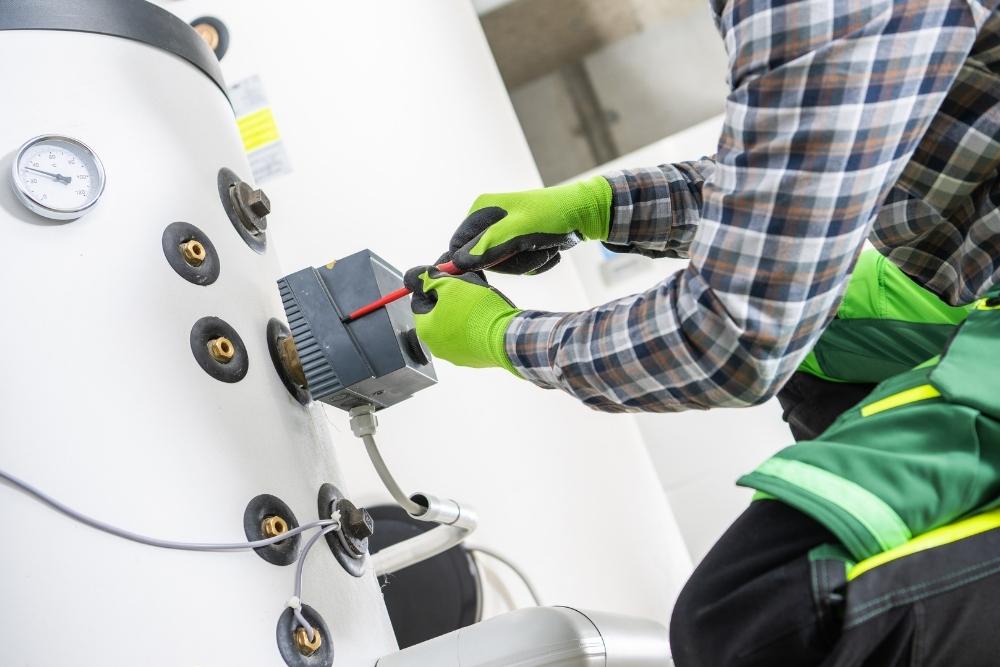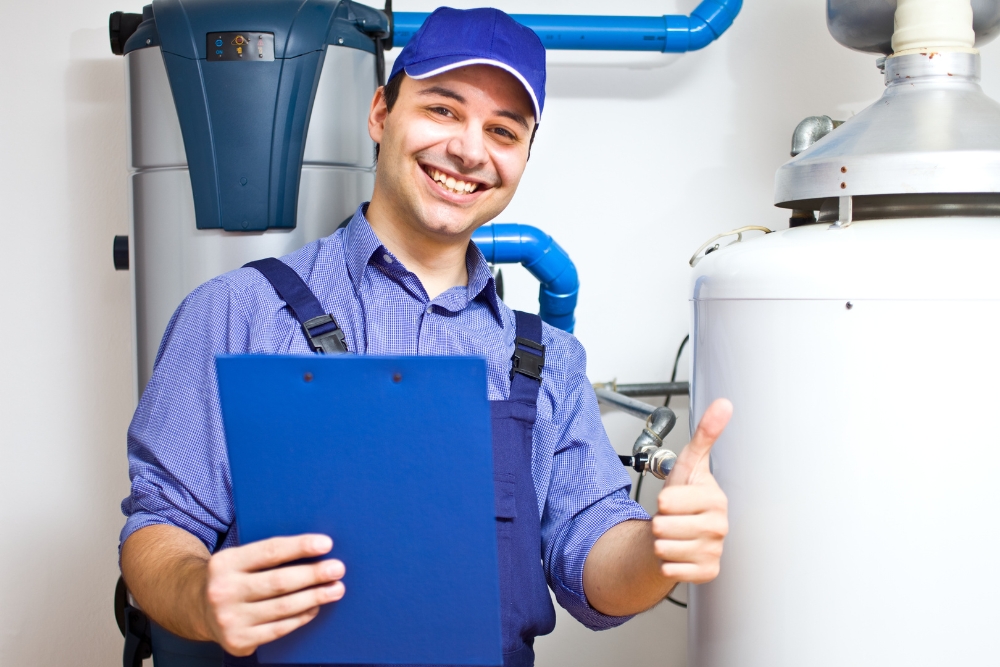We’ve all winced at the hefty price tag on our energy bill, feeling like our hot water systems are gobbling up power as quickly as a little nipper demolishes an ice cream cone. Like you, we’ve had that brisk chill down our spine from those alarming numbers and realised there must be a savvier route.
Our nifty exploration into insulation for hot water systems isn’t just about keeping things snug; it’s about being economical too. By wrapping your system up right, we can pocket savings of around 16% on our heating costs! So hang around as we spill the beans on how to keep your H2O steaming without setting your wallet ablaze – and yep, that pun was meant to warm you up!
Key Takeaways
- Insulating hot water tanks and pipes can save around 16% on heating costs because it reduces heat loss and the need to constantly reheat water.
- Proper insulation raises the temperature of your hot water by 2°F–4°F, which means you use less energy while still enjoying warm showers and efficient cleaning.
- By cutting down on energy use with insulation, we also lower carbon emissions, helping our environment.
- Thermal insulation traps warmth in the tank, while pipe lagging keeps heat in the pipes – both are key for an energy-efficient hot water system.
- Adding low-flow showerheads, and faucet aerators, and adjusting thermostat settings further improve efficiency and lead to more savings.
Understanding Hot Water Service Insulation
Understanding hot water service insulation is crucial in reducing heat loss through the hot water tank and pipes, which can result in significant energy savings. Insulating your hot water system and pipes not only helps to retain heat but also reduces carbon emissions and environmental impact.

Causes of heat loss through hot water tank and pipes
Our hot water tanks and pipes are like big thermoses, but unlike the trusty flask that keeps our coffee hot, they can lose heat quickly if not properly insulated. The tank itself radiates warmth into its surroundings unless it’s wrapped up snugly in a blanket of insulation.
And every time we transport water through pipes from the heater to our taps, some of that precious heat escapes – kind of like how warmth slips away when you open a door on a cold day.
We’ve found adding insulation is like giving our water system a cosy coat. It helps prevent this energy slip-up by keeping the heat where it belongs – with the water! Insulating those pipes also bumps up the temperature by 2°F–4°F, so we don’t have to burn more gas or electricity reheating.
Plus, with all components covered up tight – right down to valves – we’re making sure no sneaky draughts whisk away any warmth from our hot showers and dish-washing sessions.
Benefits of insulating hot water system and pipes
Insulating your hot water system and pipes brings numerous benefits. Firstly, it reduces heat loss and improves energy efficiency, resulting in significant savings on your energy bills.
Additionally, insulating your hot water tank helps to keep the water hot for longer periods, reducing the need for constant reheating. Moreover, by insulating hot water pipes, you can raise the water temperature by 2°F–4°F without using extra energy—leading to lower energy consumption.
Furthermore, insulated hot water pipes also contribute to a substantial reduction in carbon emissions by minimising energy loss.
Types of Insulation for Hot Water Tanks
When it comes to insulating hot water tanks, there are two main types of insulation to consider: thermal insulation for the tank itself and pipe lagging for the pipes connected to the tank. Both play a crucial role in reducing heat loss and improving energy efficiency.
Thermal insulation
Thermal insulation for hot water systems is a crucial step in reducing heat loss and energy consumption. By insulating the hot water tank, pipes, and valves, we can keep the water hotter for longer periods, which means less frequent reheating and lower energy usage.
This simple yet effective measure not only saves on energy costs but also contributes to a significant reduction in carbon emissions by minimising heat loss from the system. Additionally, insulated hot water pipes have been shown to raise water temperature by 2°F–4°F, further enhancing energy efficiency and cost savings over time.
Insulating your hot water system with thermal insulation not only reduces heat loss but also ensures that your home’s hot water needs are met efficiently. By incorporating this method into our homes, we can enjoy sustained comfort while making a positive impact on our environment through reduced energy consumption and lower utility bills.
Pipe lagging
Pipe lagging is a crucial aspect of insulating your hot water system. It involves wrapping insulation around the hot water pipes to prevent heat loss and maintain higher water temperatures.
By adding pipe lagging, you can reduce energy consumption and lower your utility bills. Additionally, insulated hot water pipes contribute to a significant reduction in carbon emissions by minimising energy loss, making it an environmentally friendly choice for homeowners.
Properly installed pipe lagging can raise water temperature by 2°F–4°F, allowing your hot water system to operate more efficiently. With this simple addition, you can enjoy warmer water while saving on energy costs and reducing environmental impact.

How to Insulate Your Hot Water System and Pipes
To insulate your hot water storage tank, start by purchasing a water heater insulation blanket and carefully wrapping it around the tank. As for the pipes, measure and cut pipe lagging to fit before securing it in place with cable ties or duct tape for maximum heat retention.
Steps for insulating hot water storage tank
To insulate the hot water storage tank, first, measure its dimensions to determine the amount of insulation needed. Then, cut the insulation material to fit the tank’s shape, leaving space for controls and ports. Next, wrap the insulation around the tank and secure it with tape or fasteners. After that, seal any gaps or seams with heat-resistant tape to prevent heat loss. Finally, ensure that the top of the tank is properly insulated to prevent heat from escaping.
Installing pipe lagging
- Measure the length of the pipes accurately to ensure you purchase sufficient lagging material.
- Clean the pipes thoroughly before beginning installation to remove any dirt or debris that may affect adhesion.
- Cut the pipe lagging to fit each section of pipe snugly, ensuring there are no gaps or exposed areas.
- Secure the pipe lagging in place using suitable adhesive or fasteners, ensuring a tight and secure fit along the entire length of the pipes.
- Inspect the insulation regularly to ensure it remains intact without any damage or displacement.
- Consider professional assistance if needed, particularly for hard-to-reach areas or more complex piping configurations.
- Monitor energy consumption and temperature changes after installation to gauge the impact of pipe lagging on overall energy efficiency.
Additional Ways to Make Your Hot Water System More Energy Efficient
Adjusting thermostat settings to a lower temperature can also help reduce energy consumption while ensuring that your hot water system is positioned in an area with adequate ventilation and insulation can further improve its efficiency.
Installing water-saving devices such as low-flow showerheads and faucet aerators is also effective in reducing water usage, which ultimately contributes to energy savings.
Adjusting thermostat settings
To improve energy efficiency, adjusting thermostat settings can help regulate the temperature of your hot water system more effectively. Lowering the thermostat by just a few degrees can result in noticeable cost and energy savings while still maintaining optimal comfort.
By setting the thermostat to an appropriate level, you can reduce both heat loss and carbon emissions, contributing to a more sustainable and eco-friendly home environment.
Optimising your hot water system’s thermostat settings not only helps minimise energy consumption but also extends the lifespan of your equipment. Ensuring that the temperature is set at a level that meets your household’s needs without being excessive will result in significant long-term benefits for both your pocket and the environment.
Optimal positioning of the system
Positioning your hot water system in an optimal location can help improve its energy efficiency and performance. Placing the water heater closer to the areas where hot water is frequently used reduces heat loss through the pipes, resulting in lower energy consumption and cost savings.
Additionally, positioning the system near a source of warmth, such as a sunny spot or near other heated equipment, can further assist in maintaining water temperature without overworking the heater.
Thinking about how you position your hot water system is essential for maximising its effectiveness and minimising energy usage. By taking these simple steps, you can ensure that your hot water service operates efficiently while saving on energy costs.
Installing water-saving devices
When optimising the energy efficiency of your hot water system, it’s essential to consider installing water-saving devices. By adding low-flow taps and showerheads, you can reduce water consumption without compromising on performance.
Additionally, incorporating aerators into your taps can help control and regulate the flow of water, ultimately decreasing wastage while still maintaining sufficient pressure for daily use.
To further enhance the conservation of hot water in your home, investing in a high-efficiency washing machine ensures that less hot water is utilised during laundry cycles. Not only does this contribute to overall energy savings, but it also minimises the impact on both your utility bills and environmental footprint.
Importance and Benefits of Hot Water Service Insulation.
Insulating your hot water system and pipes is crucial for reducing heat loss and saving energy. It keeps the water hot for longer, cutting down the need to reheat frequently. Insulated pipes can raise water temperature by 2°F–4°F, leading to lower energy consumption.
By insulating your hot water tank and pipes, you contribute to a significant reduction in carbon emissions and save on energy costs in the long run.






